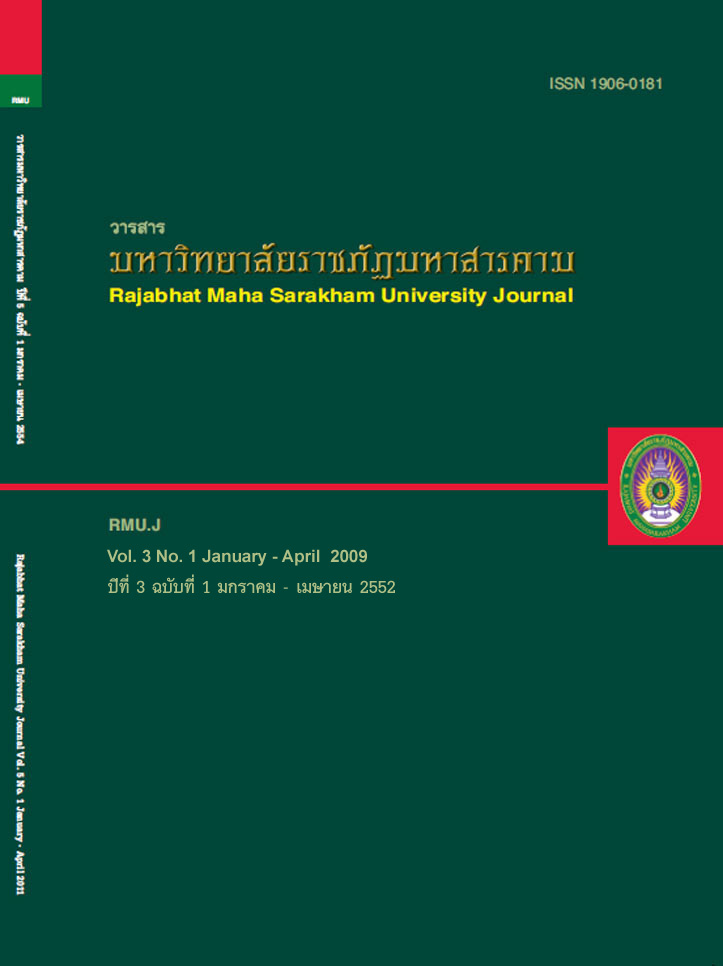การศึกษาภูมิปัญญาท้องถิ่นจากวรรณกรรมอีสานเรื่องสุวรรณจักรกุมาร The Study of Local Wisdom of North-East Literature : A Case Study Suwannajakkumarn
Main Article Content
บทคัดย่อ
การวิจัยนี้มีวัตถุประสงค์ ประการแรกเพื่อปริวรรตวรรณกรรม เรื่อง สุวรรณจักรกุมาร จากอักษรธรรมอีสานเป็นอักษร ไทยราชการ ประการที่สองเพื่อศึกษาภูมิปัญญาด้านการใช้ภาษา และประการที่สามเพื่อศึกษาภูมิปัญญาด้านคำสอน โดยการวิจัย
จากเอกสารใบลานวรรณกรรมอีสาน เรื่อง สุวรรณจักรกุมาร จำนวน 8 ผูก 147 ลาน การวิเคราะห์ข้อมูลด้วยวิธีพรรณนาวิเคราะห์ ผลการวิจัยพบว่า วรรณกรรมอีสาน เรื่องสุวรรณจักรกุมารมีเค้าโครงมาจากพระสุตตันตปิฎก ในพุทธศาสนา เนื้อหากล่าวถึง พระโพธิสัตว์
ซึ่งเสวยพระชาติเป็นสุวรรณจักรกุมารได้สอนให้คนทั้งหลายปฏิบัติถูกต้องตามหลักคุณธรรมจริยธรรม ต้นฉบับเป็นหนังสือผูก ใบลานมีผู้คัดลอกเพื่อใช้เทศนาสืบต่อกันมา การปริวรรตวรรณกรรมนี้ใช้หลักการปริวรรตโดยเน้นเขียนคำที่คนปัจจุบันส่วนใหญ่
เข้าใจเป็นหลัก หากคำใดไม่ปรากฏในภาษาไทยราชการก็ปริวรรตตามเสียงอ่าน เพื่อเป็นแนวทางในการปริวรรตอักษรธรรมอีสาน และเพื่อให้ผู้สนใจศึกษาวรรณกรรมเรื่องนี้แต่ไม่สามารถอ่านอักษรธรรมอีสานได้ก็สามารถเรียนรู้จากฉบับปริวรรตนี้ ภูมิปัญญา
ด้านการใช้ภาษา พบว่า วรรณกรรมอีสานเรื่องสุวรรณจักรกุมารมีลักษณะฉันทลักษณ์แบบร้อยแก้ว สำนวนเทศน์ มีจุณณียบท
คือ ยกภาษาบาลีขึ้นแล้วถอดเป็นภาษาถิ่นอีสานอธิบายเป็นตอนๆ การใช้ภาษาสมบูรณ์ด้วยการใช้คำสัมผัส คำซ้ำ คำซ้อน และ
โวหาร เพื่อให้ผู้อ่าน ผู้ฟังเกิดความซาบซึ้งในวรรณกรรมและเกิดศรัทธาตามเนื้อหา สามารถเข้าใจเนื้อเรื่องตลอดจนสาระสำคัญที่
เป็นประโยชน์ต่อผู้รับสารอันเป็นการแสดงถึงภูมิปัญญาของผู้ประพันธ์ที่แสดงความสามารถการใช้ภาษาในการประพันธ์ ส่วน
ภูมิปัญญาด้านคำสอน พบว่า มีคำสอนที่สะท้อนแนวคิดจากคลอง 14 อันเป็นบรรทัดฐานในการปฏิบัติตนของชาวอีสานมี5 ประการ ได้แก่ คำสอนด้านครอบครัว การประกอบอาชีพ ความเชื่อและศาสนา ค่านิยม และการปกครอง คำสอนเหล่านี้ล้วนมี
ข้อชี้แนะให้ปฏิบัติทั้งทางโลกและทางธรรมอย่างบริบูรณ์ เพื่อให้ผู้รับสารสามารถนำไปปรับใช้กับชีวิตประจำวันได้อย่างเหมาะสมซึ่งจะทำให้ครอบครัว ชุมชน และสังคมอีสานสามารถอยู่ร่วมกันได้อย่างสงบสุข
The purposes of this study were to transcribe a Northeastern (Isan) literary work,
Suwannajakkumarn, from the Dhamma alphabet to the Thai official alphabet, to study wisdom regarding
language use and to study wisdom regarding teachings found in this literature, which consisted of 8
bindings (pook) and 147 palm leaves (lan). Data were analyzed through descriptive analysis. Findings of
study revealed that this Isan literature, Suwannajakkumarn, originated from the plot outline of Phra
Suttantapitapitaka, a story of Buddha’s reincarnation as Suwannajakkumarn , teaching ethics and moral
conduct. The palm-leaf manuscript of this story was later copied and used for teaching moral ways of living
for ethical conduct. The transcription of this literature mainly focused on words, especially emphasizing
words understood by modern people. Words not found in the official Thai language were phonically
transcribed. The transcription aimed to offer guidelines for transcribing the Isan Dhamma alphabet, and to
enable those, who are interested in the story but lack Dhamma alphabet reading ability, to learn from the
transcribed version.
Regarding the wisdom found in language used, this Isan literature, Suwannajakkumarn, was
written in sermon- styled prose, consisting of examples Bali language transcribed into Isan dialect section
by section, the language use complete with rhymes, couplets, repeated words, and witty expressions;
enabling readers to appreciate literature, have faith in its content, and understand essential elements
useful to the readers. This shows the author’s wisdom regarding language use in literary writing. They
could easily be understood and benefited which showed the author’s wisdom and ability in composing
this precious literature.
For wisdom regarding teachings found in this literature, the study revealed that teachings found
in this literary work reflect thinkings from “Klong 14”, set as 5 norms of the Isan ways of personal conduct:
family, career, belief & religion, value, and government. These teachings offer readers guidelines of
practice, both world knowledge and Dhamma, to be appropriately applied in daily life, leading to mutual
happiness and peace in the family, community, and the Isan society.
Article Details
1. บทความที่ลงตีพิมพ์ทุกเรื่องได้รับการตรวจทางวิชาการโดยผู้ประเมินอิสระ ผู้ทรงคุณวุฒิ (Peer Review) สาขาที่เกี่ยวข้อง อย่างน้อย 3 ท่าน ในรูปแบบ Double blind review
2. ข้อคิดเห็นใด ๆ ของบทความที่ลงตีพิมพ์ในวารสารมหาวิทยาลัยราชภัฏมหาสารคาม นี้เป็นของผู้เขียน คณะผู้จัดทำวารสารไม่จำเป็นต้องเห็นด้วย
3. กองบรรณาธิการวารสารมหาวิทยาลัยราชภัฏมหาสารคาม ไม่สงวนสิทธิ์การคัดลอกแต่ให้อ้างอิงแสดงที่มา


